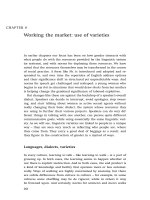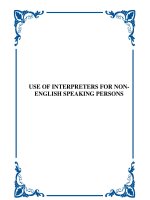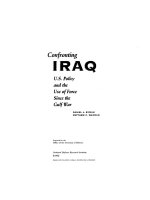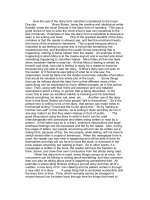Use Of Force - Introduction - Worksheet
Bạn đang xem bản rút gọn của tài liệu. Xem và tải ngay bản đầy đủ của tài liệu tại đây (84.38 KB, 18 trang )
Use Of Force: Introduction: Worksheet
Pre Reading
1. Working in pairs. Look at the following words and discuss what they mean. Try to give
examples for each of them.
Rules of Engagement Hostile Act Hostile Intent
Minimum Force Non- Deadly Force Deadly Force
2. With the whole class. Share your ideas with your colleagues. Give some examples. Do
you have examples from your own experience or stories colleagues have told you?
Read the article “To Shoot or not to shoot”
3. Find and write definitions for the following
Rules of Engagement ……………………………………………………………………
Hostile Act …………………………………………………………………….
Hostile Intent ……………………………………………………………………...
Minimum Force ……………………………………………………………………....
Non- Deadly Force ……………………………………………………………………...
Deadly Force ………………………………………………………………………
4. Find and write down examples for the following
Hostile Act …………………………………………………………………….
Hostile Intent ……………………………………………………………………...
Minimum Force ……………………………………………………………………....
Non- Deadly Force ……………………………………………………………………...
Deadly Force ………………………………………………………………………
After Reading
5. With a partner prepare a briefing based on information in the article.
6. Change partners, give your briefing to your new partner and listen to your partner
giving his briefing. Talk about what was the same and what was different. Comment on
how well your partner gave his briefing
Attention! A Military English Course for NCOs
To shoot or not to shoot?
From our army correspondent
A soldier is at a checkpoint. A man is
shouting at him. A section is on patrol. A
crowd gathers and throws rocks at it. A
soldier sees a local man lift a rifle and
point it at another local person. What do
soldiers do in these situations? How do
they know how to do the right thing? Well,
they have learnt rules to help them. They
have learnt the Rules of Engagement, which
are the rules that tell a soldier when to use
force and when not to use force and how
much force to use.
Every conflict and every peacekeeping
mission has its own Rules of Engagement,
and a soldier has a duty to learn the Rules of
Engagement for the mission he is on, but
there are some things that are common to all
operations.
For example, when do peacekeepers use
force? Well, I must repeat, each PKO will
have its own specific rules, but generally
force can be used in two circumstances.
When there is a hostile act or when there is
hostile intent. A hostile act is an actual
attack on peacekeeping forces, such as
throwing bricks at a patrol. Hostile intent is
when there isn’t an actual attack, but there is
a strong threat of an attack. A soldier sees a
person lifting a rifle and aiming at another
person. The soldier believes a person will be
killed. The person lifting the rifle has hostile
intent and the soldier can use force to stop
them from firing.
The first rule is that the soldier should use
minimum force. That is, he should only use
as much force as is necessary. If a young
man runs at a soldier with a wooden club,
that soldier should not shoot the young man.
That would be too much force. A trained
soldier can take the wooden club off the
young man without harming him too much.
He would be using minimum force.
However, if three young men with knives
are running at a soldier and the soldier has
no way of escaping, then that soldier could
fire his weapon. That too would be
minimum force. Minimum force is using the
smallest amount of force necessary in the
situation. That could be a little or a lot. It
depends on the situation.
But soldiers always try to use non-deadly
force. That is force that does not use a rifle
or other deadly weapon. Examples of non-
deadly force are pushing or hitting. Also, a
soldier can physically restrain a person,
perhaps by grabbing and holding them, or by
putting handcuffs on them, or tying their
hands and legs in some way. Non-deadly
force also includes firing your weapon in the
air to give a warning.
But soldiers may sometimes have to use
deadly force. That is force which is intended
or is likely to cause death or grievous bodily
harm, that is serious injury, to a person.
Examples of deadly force are shooting at
people or using another deadly weapon,
such as a knife. But soldiers only use deadly
force under conditions of extreme necessity
and as a last resort, when all other means
have failed or cannot be employed. An
example would be if a soldier is being fired
on and cannot escape. Then he can return
fire and use deadly-force.
Attention! A Military English Course for NCOs
Use Of Force: Introduction: Answer Key
3. Find and write definitions for the following
Rules of Engagement rules that tell a soldier when to use force and when not to use
force and how much force to use.
Hostile Act an actual attack on peacekeeping forces
Hostile Intent when there isn’t an actual attack, but there is a strong threat of
an attack
Minimum Force only use as much force as is necessary
Non- Deadly Force force that does not use a rifle or other deadly weapon
Deadly Force force which is intended or is likely to cause death or grievous
bodily harm
4. Find and write down examples for the following
Hostile Act throwing bricks at a patrol
Hostile Intent a person lifting a rifle and aiming at another person.
Minimum Force disarming a young man who has a club
Non- Deadly Force pushing, hitting, grabbing, holding, putting on handcuffs, tying
hands and legs
Deadly Force shooting at people or using another deadly weapon, such as a
knife.
Use of Force: Principles and Concepts: Listening Text One
Right, so I’m going to talk to you a little about the use of force in peacekeeping operations and
some of the basic principles and ideas behind the use of force.
First of all, the use of force on PKOs must have positive control. That is the commander who is
actually there where the force is being deployed should control that force. Not someone back in
HQ who can’t see what is going on on the ground. And, all force must cease, that is stop, once the
aim has been achieved.
Oh, and then there’s minimum force. You must never use more force than is necessary. Only use
as much force as is needed to carry out duties and to accomplish the assigned objectives of the
mission.
What else, well, force is used as a last resort. If the operational situation permits, you should try
everything else to resolve potential hostile confrontation. If you have the time, try negotiation.
Try a show of force. Force can only be used when there is no other way to stop an illegal action
or to achieve the objective you have been authorized to do.
And another thing, you shouldn’t escalate the force without authorisation. That is, you can’t use
more force unless you are ordered to do so.
Well, there are a lot of rules about the use of force. Another one I remember is about collateral
damage. That is accidentally causing injury to people or damage to structures. Well, this
collateral damage, this unintentional injury and damage, should be minimized. Ideally, there
should be none, but these things happen sometimes.
Use of Force: Principles and Concepts: Listening Text Two
So, you’ve already heard something about the use of force in peacekeeping operations. I will give
you some more information.
And then there’s proportionality. That is the amount of force you use should depend on the level
of threat you are facing. If some kids are throwing stones, then just protect yourself and maybe
run out to catch some ringleaders. That would be proportional response. Shooting them wouldn’t
be.
One very important thing to remember is that you, as peacekeepers, have a right to hold your
position. There is no requirement to retreat in order to avoid situations. And you can use force to
defend yourself and hold your position. However, sometimes the best way to avoid injury is to
retreat. That will be a decision a commander on the ground will take.
You remember I said that the use of force should only be used as a last resort. That is after you’ve
tried other things. Well, one of those other things you could try is to negotiate and give warnings.
You should really try to control the situation through measures short of force. Try personal
contact and negotiation. Give a warning to the hostile force, telling them that you will defend
yourself with force if necessary.
Only when you have exhausted all other options, when you have tried everything else, should you
use force. I repeat, force can only be used when there is no other feasible way of either stopping
the illegal act or doing the job you’ve been told to do.
Oh, one last thing. Retaliation and reprisals are not allowed. You are not allowed to use force just
because you want revenge.
Use of Force: Principles and Concepts: Worksheet 1
1. On your own. You are going to listen to a person give a talk on the basic principles and
ideas for the use of force (Tapescript One). Don’t look at the rest of this worksheet.
Listen once and make notes on the main ideas of what the person says.
2. In pairs, compare your notes with your partner.
3. On your own. Below is a list of the five main topics that the speaker talks about.
Without listening write notes for each heading.
Positive Control Minimum Force Last Resort Escalation of Force Collateral Damage
4.
In pairs, compare your notes with your partner
5.
On your own, now listen to the tape again and write notes under each heading.
6.
In pairs, compare your notes with a partner
7.
Whole Class. Your teacher will ask the whole class for their notes on these topics. Listen, be
ready to answer your teacher and add if you hear something new, add it to your notes.
8.
Listen again and fill the gaps in the following sentences.
a) The commander who is actually there where the force is being …………… should
control that force.
b) Not someone back in HQ who can’t see what is going on ……… …………….
…………….
c) Only use as much force as is needed to ………… …………… ……………. and to
accomplish the assigned objectives of the mission.
d) If the operational situation permits, you should try everything else to ……………..
potential hostile confrontation.
e) And another thing, you shouldn’t ………… …………. ……………. without
authorisation. That is, you can’t use more force unless you are ordered to do so.
f)
Well, this collateral damage, this unintentional injury and damage, ……… …….
…………… Ideally, there should be none, but these things happen sometimes.
9.
In pairs. Now compare your answers with a partner.
10.
Whole class feedback.
11.
Now write a short report on the use of force, based on what you have learnt in this lesson.
Attention! A Military English Course for NCOs
Use of Force: Principles and Concepts: Worksheet 2
1. On your own. You are going to listen to a person give a talk on the basic principles and
ideas for the use of force (Tapescript Two). Don’t look at the rest of this worksheet.
Listen once and make notes on the main ideas of what the person says.
2. In pairs, compare your notes with your partner.
3. On your own. Below is a list of the four main topics that the speaker talks about.
Without listening write notes for each heading.
Proportionality Holding your position Negotiate and Warn Retaliation and reprisals
4. In pairs, compare your notes with your partner
5. On your own, now listen to the tape again and write notes under each heading.
6. In pairs, compare your notes with a partner
7. Whole Class. Your teacher will ask the whole class for their notes on these topics.
Listen, be ready to answer your teacher and add if you hear something new, add it to your
notes.
8. Listen again and fill the gaps in the following sentences.
a) The amount of force you use should depends on the ………………………………
you are facing
b) You can use force to defend yourself and …………………………………….. .
c) You should really try to control the situation through measures …………………..
force.
d) I repeat, force can only be used when there is no other ………………………….
of either stopping the illegal act or doing the job you’ve been told to do.
e) You are not allowed to use force just because you ……………………………….
9. In pairs. Now compare your answers with a partner.
10. Whole class feedback.
11. Now write a short report on the use of force, based on what you have learnt in this
lesson.
Attention! A Military English Course for NCOs
Use Of Force: Principles and Concepts One: Answer Key
8. Listen again and fill the gaps in the following sentences.
a) The commander who is actually there where the force is being deployed should
control that force.
b) Not someone back in HQ who can’t see what is going on on the ground
c) Only use as much force as is needed to carry out duties and to accomplish the
assigned objectives of the mission.
d) If the operational situation permits, you should try everything else to resolve
potential hostile confrontation.
e) And another thing, you shouldn’t escalate the force without authorisation. That
is, you can’t use more force unless you are ordered to do so.
f) Well, this collateral damage, this unintentional injury and damage should be
minimized. Ideally, there should be none, but these things happen sometimes
Use Of Force: Principles and Concepts Two: Answer Key
8. Listen again and fill the gaps in the following sentences.
a) The amount of force you use should depends on the level of threat you are facing
b) You can use force to defend yourself and
hold your position
c) You should really try to control the situation through measures
short of
force.
d) I repeat, force can only be used when there is no other
feasible way
of either
stopping the illegal act or doing the job you’ve been told to do.
e) You are not allowed to use force just because you
want revenge.









